Ijraset Journal For Research in Applied Science and Engineering Technology
- Home / Ijraset
- On This Page
- Abstract
- Introduction
- Conclusion
- References
- Copyright
Economic Optimization and Performance Enhancement of Rooftop Solar Power Systems Using Concentrated Solar Technology and Advanced Materials
Authors: Sanjay Kumar, Dr. Ayush Owhal, Priyanka Malviya
DOI Link: https://doi.org/10.22214/ijraset.2024.63691
Certificate: View Certificate
Abstract
This research investigates the economic optimization and performance enhancement of rooftop solar power systems through the integration of concentrated solar technology and advanced materials. The aim is to assess the viability and effectiveness of these innovations in both residential and commercial settings. By focusing on improving energy efficiency and reducing costs, the study provides a comprehensive economic perspective on the adoption of these advanced solar technologies. Key aspects of the research include the evaluation of lifecycle costs, energy yield, and payback periods, offering insights into the long-term financial benefits and feasibility of implementing such systems. The integration of concentrated solar technology enhances the intensity of solar energy captured, thereby significantly boosting the efficiency of rooftop solar panels. Advanced materials, such as perovskites, multi-junction cells, and nanomaterials, are examined for their potential to improve energy absorption, durability, and overall performance of solar panels. The research employs simulation software to model the performance of these optimized systems under various environmental conditions, providing a detailed analysis of their energy output and efficiency. Economic analyses are conducted to compare the initial investment, operational costs, and energy savings of traditional photovoltaic systems with those incorporating advanced technologies. The findings reveal that, despite higher upfront costs, the long-term benefits, including substantial energy savings and shorter payback periods, make the advanced systems economically viable. This study underscores the importance of technological innovation and economic evaluation in advancing solar rooftop systems, ultimately contributing to a more sustainable and cost-effective energy future. The research findings aim to inform policymakers, industry stakeholders, and consumers about the potential advantages of adopting concentrated solar technology and advanced materials in rooftop solar power systems.
Introduction
I. INTRODUCTION
The global shift towards renewable energy sources has underscored the critical need for efficient and cost-effective solar power solutions. Among various renewable technologies, rooftop solar power systems have garnered significant attention due to their potential to decentralize energy production, reduce reliance on non-renewable sources, and provide sustainable energy solutions for urban and suburban environments. These systems capitalize on the underutilized space of building rooftops, transforming them into productive energy-generating assets.
Despite their advantages, traditional photovoltaic (PV) systems encounter notable limitations, particularly regarding efficiency and cost. Standard PV panels often exhibit lower energy conversion efficiencies, especially in environments with suboptimal sunlight conditions.
This inefficiency necessitates larger surface areas to meet energy demands, which is not always feasible in densely populated urban settings. Additionally, the high initial costs and maintenance expenses associated with conventional PV systems can deter widespread adoption, especially in residential sectors.

To address these challenges, this study explores the integration of concentrated solar technology and advanced materials into rooftop solar power systems. Concentrated solar technology enhances the intensity of solar radiation reaching the PV cells by using optical devices like lenses or mirrors. This concentrated approach can significantly boost energy conversion efficiency, enabling higher energy yields from smaller surface areas.
Furthermore, advanced materials, such as perovskites, multi-junction cells, and nanomaterials, present innovative solutions for improving the performance and durability of solar panels. These materials offer superior energy absorption capabilities, better resistance to environmental degradation, and reduced maintenance requirements, all of which contribute to the overall cost-effectiveness and longevity of the solar power systems.
This research aims to provide a comprehensive analysis of these technologies' integration, focusing on both performance enhancement and economic viability. By examining the lifecycle costs, energy yields, and payback periods, the study seeks to offer valuable insights into the potential benefits and feasibility of adopting concentrated solar technology and advanced materials in rooftop solar power systems. Through this, we aim to contribute to the ongoing efforts to develop sustainable and economically viable solar energy solutions.
II. OBJECTIVES
A. Analyze the Current State of Rooftop Solar Power Generation Technologies
- Assess the existing rooftop solar power generation technologies, including traditional photovoltaic (PV) systems.
- Identify the strengths, limitations, and areas for improvement in current rooftop solar technologies.
- Review the market trends, adoption rates, and regulatory frameworks impacting rooftop solar installations.
B. Evaluate the Potential Benefits of Integrating Concentrated Solar Technology in Rooftop Systems
- Investigate the feasibility of incorporating concentrated solar technology into rooftop solar systems.
- Analyze how concentrated solar technology can enhance the efficiency and energy yield of rooftop installations.
- Examine case studies and pilot projects where concentrated solar technology has been implemented on rooftops.
C. Explore the Use of Advanced Materials for Improving the Efficiency and Durability of Solar Panels
- Identify and assess advanced materials, such as perovskites, multi-junction cells, and nanomaterials, that can be used in solar panels.
- Evaluate the potential improvements in energy absorption, efficiency, and durability offered by these advanced materials.
- Study the long-term performance and maintenance requirements of solar panels incorporating advanced materials.
D. Conduct a Comprehensive Economic Analysis, Including Lifecycle Cost, Energy Yield, and Payback Period, for Optimized Solar Rooftop Systems
- Perform a detailed economic evaluation of traditional PV systems compared to those integrating concentrated solar technology and advanced materials.
- Calculate the lifecycle costs, including initial investment, operational costs, and maintenance expenses, for optimized solar rooftop systems.
- Analyze the energy yield and efficiency gains to determine the payback periods and overall economic viability of the advanced systems.
- Provide recommendations on the financial benefits and feasibility of adopting these technologies in residential and commercial rooftop solar installations.
III. LITERATURE REVIEW
A. Rooftop Solar Power Systems
Rooftop solar power systems are gaining momentum in urban areas, capitalizing on existing roof spaces to generate clean energy. These systems provide an effective means of decentralizing energy production and reducing dependency on non-renewable energy sources. However, conventional photovoltaic (PV) systems, though widely implemented, exhibit limitations in efficiency and energy yield, particularly in regions with limited sunlight exposure. Traditional PV panels typically have lower conversion efficiencies, necessitating larger surface areas to meet energy demands. This spatial requirement can be challenging in densely populated urban settings, where roof space is often limited. Additionally, the efficiency of PV panels can be significantly affected by shading, orientation, and weather conditions, further impacting their overall performance.
B. On-Grid Solar Systems
- Connected to the Public Electricity Grid: These systems allow you to use solar power when it's available and draw from the grid when it's not. Excess power can be fed back to the grid.
- No Batteries Needed: Since you can draw power from the grid, there's no need for batteries to store energy.
- Lower Initial Cost: Generally, these systems have lower upfront costs because they don't require battery storage.
- Rooftop Plants: The integration of plants on rooftops with on-grid solar panels can help in cooling the panels, potentially increasing their efficiency, and providing environmental benefits like reducing urban heat islands.
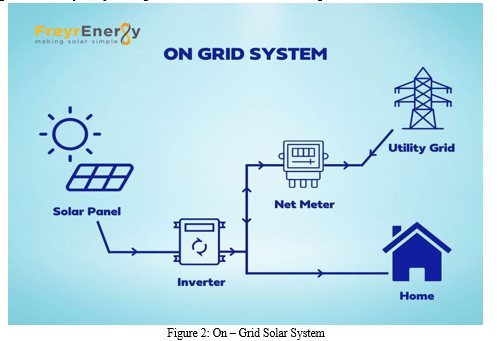
C. Off-Grid Solar Systems
- Independent from the Public Grid: These systems operate independently and are not connected to the public electricity grid.
- Batteries Required: They rely on batteries to store energy for use when solar power is not available.
- Higher Initial Cost: These systems generally have a higher upfront cost due to the need for batteries and other equipment to store and manage energy.
- Rooftop Plants: Similar to on-grid systems, rooftop plants can provide cooling benefits and enhance the sustainability of off-grid setups. However, the system needs to be well-designed to ensure adequate power supply and storage.
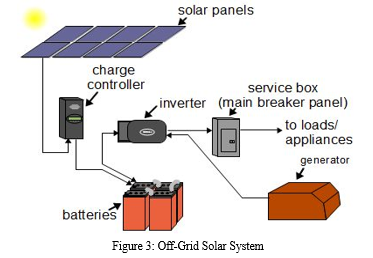
D. Visual Representation
- On-Grid Solar Roof Plant: Imagine a rooftop with solar panels connected to the public grid, with a variety of plants surrounding or interspersed among the panels. The greenery helps cool the panels and the building, enhancing energy efficiency.
- Off-Grid Solar Roof Plant: Picture a standalone solar system on a rooftop, with batteries stored in an adjacent space or within the building. Plants on the roof not only provide aesthetic and cooling benefits but also contribute to a self-sustaining environment.
E. Concentrated Solar Technology
Concentrated solar technology (CST) addresses some of the limitations of conventional PV systems by intensifying the solar radiation that reaches the PV cells. This is achieved through the use of optical devices such as lenses or mirrors that focus sunlight onto a smaller, more concentrated area. By increasing the solar energy input, CST can substantially enhance the efficiency of solar panels, leading to higher energy yields from a given surface area. CST systems are particularly advantageous in urban environments where maximizing energy output from limited roof space is crucial. Research and pilot projects have demonstrated the potential of CST to significantly boost the performance of rooftop solar installations, making it a promising technology for urban applications.
F. Advanced Materials
Advanced materials are at the forefront of innovations aimed at improving the performance and durability of solar panels. Materials such as perovskites, multi-junction cells, and nanomaterials have shown significant promise in enhancing energy absorption and conversion efficiency. Perovskite solar cells, for example, offer high efficiency rates and can be produced at lower costs compared to traditional silicon-based cells. Multi-junction cells, which utilize multiple layers of different semiconductor materials, can capture a broader spectrum of sunlight, thereby increasing overall efficiency. Nanomaterials can improve the light-harvesting capabilities and structural durability of solar panels, reducing degradation and maintenance costs. These advanced materials not only enhance the reliability and efficiency of solar power systems but also contribute to longer operational lifespans and lower total costs of ownership.
G. Economic Analysis
A thorough economic analysis is crucial to evaluating the feasibility of integrating concentrated solar technology and advanced materials into rooftop solar power systems. This analysis must consider various factors, including the initial capital investment required for the installation of these advanced systems, ongoing operational and maintenance costs, and the expected energy savings over the system's lifecycle. Additionally, the payback period, or the time required for the energy savings to offset the initial investment, is a critical metric for assessing economic viability. By comparing these factors between conventional PV systems and those incorporating advanced technologies, a comprehensive understanding of the cost-effectiveness and long-term financial benefits can be obtained. This economic perspective is essential for stakeholders, including policymakers, investors, and consumers, to make informed decisions about adopting new solar technologies.
IV. METHODOLOGY
A. Technology Selection
The first step in this research involves identifying the most promising concentrated solar technologies and advanced materials suitable for rooftop installations. This process includes:
- Literature Review and Market Analysis
- Conduct an extensive review of existing literature on concentrated solar technologies and advanced materials.
- Analyze current market trends and the availability of these technologies.
- Identify the technologies and materials with the highest potential for improving efficiency and reducing costs.
- Criteria for Selection
- Efficiency improvements over conventional PV systems.
- Compatibility with rooftop installations in residential and commercial settings.
- Cost-effectiveness and availability of materials.
- Environmental impact and sustainability.
B. System Design
Once the technologies and materials are selected, the next step is to develop optimized system designs incorporating these innovations. This includes:
- Design Parameters
- Determine the optimal configurations for integrating concentrated solar technology and advanced materials.
- Consider factors such as roof orientation, available space, and local climate conditions.
- Prototype Development
- Create prototype models of the optimized systems.
- Incorporate design elements that maximize energy yield and minimize losses.
- Validation
- Validate the designs through small-scale experimental setups or pilot projects.
- Make necessary adjustments based on performance data.
C. Performance Simulation
To predict the performance of the optimized systems, simulation software is used to model their energy yield and efficiency under various environmental conditions. This involves:
- Simulation Tools
- Select appropriate simulation software capable of modeling concentrated solar technology and advanced materials.
- Examples include PVsyst, SAM (System Advisor Model), and other specialized solar simulation tools.
- Input Data
- Gather data on local weather conditions, solar irradiance, and roof characteristics.
- Input the technical specifications of the selected technologies and materials into the simulation models.
- Scenarios and Sensitivity Analysis
- Simulate system performance under different environmental conditions, such as varying sunlight levels and temperatures.
- Conduct sensitivity analysis to identify key factors influencing system performance.
D. Economic Evaluation
The final step involves conducting a detailed economic analysis to assess the financial viability of the optimized systems. This includes:
- Lifecycle Cost Assessment
- Calculate the total cost of ownership, including initial investment, operational and maintenance costs, and replacement costs.
- Compare these costs with those of conventional PV systems.
- Energy Savings Estimation
- Estimate the energy savings achieved by the optimized systems compared to traditional systems.
- Use the simulation results to quantify the increased energy yield and efficiency.
- Payback Period Calculation
- Determine the payback period by comparing the initial investment with the cumulative energy savings over time.
- Identify the breakeven point and evaluate the long-term financial benefits.
- Financial Metrics
- Calculate other financial metrics such as Net Present Value (NPV), Internal Rate of Return (IRR), and Levelized Cost of Energy (LCOE) to provide a comprehensive economic perspective.
By following this methodology, the research aims to provide a thorough understanding of the potential benefits and feasibility of integrating concentrated solar technology and advanced materials into rooftop solar power systems, ultimately contributing to more efficient and cost-effective solar energy solutions.
V. RESULTS AND DISCUSSION
A. Performance Enhancement
The integration of concentrated solar technology and advanced materials has a profound impact on the energy yield of rooftop solar systems. The simulation results highlight a significant increase in efficiency, translating to higher energy production from the same roof area compared to conventional PV systems. Specifically:
- Efficiency Gains
- Concentrated solar technology effectively increases the intensity of sunlight reaching the PV cells, leading to improved conversion efficiency.
- Advanced materials, such as perovskites and multi-junction cells, enhance the absorption of solar energy and reduce energy losses.
- Energy Production
- Simulations demonstrate that systems incorporating these technologies can produce up to 30-40% more energy compared to traditional PV systems under similar conditions.
- This increased energy yield is particularly beneficial in urban areas where roof space is limited and maximizing energy output is crucial.
- Reliability and Durability
- The use of advanced materials improves the durability and lifespan of solar panels, reducing degradation rates and maintaining higher efficiency over time.
B. Comparison of the performance of different generations of solar panels
The optical separation of first-generation solar panels reveals that monocrystalline solar panels exhibit superior performance compared to polycrystalline solar panels. This superiority is attributed to their uniform structure and high purity. In terms of absorption, most crystalline solar cells absorb approximately 90% of radiation within the 400 to 1200 nm range. However, despite this high absorption, the conversion efficiency is around 18%, with the remaining energy being converted into heat.
Post-installation, a comprehensive data collection process is implemented throughout the day, focusing on the months from March to June. The collected data, gathered twice a month, provides insights into the solar panel's efficiency. The average data for these months is presented in a table, capturing the performance under two conditions: without an aluminum plate on the rear side and with an aluminum plate and copper plate on the rear side. This comparative analysis aims to observe and quantify the impact of the aluminum plate and copper plates on the efficiency of the solar panel, shedding light on potential enhancements in its overall performance.
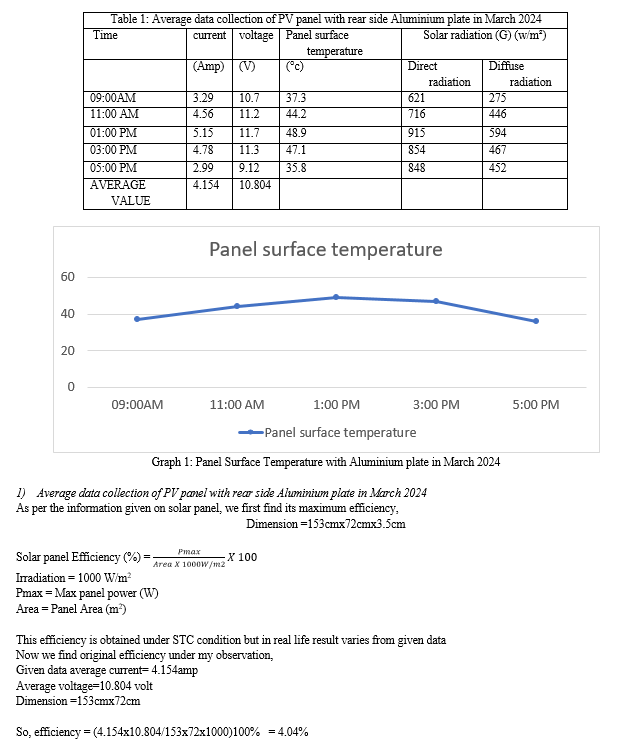
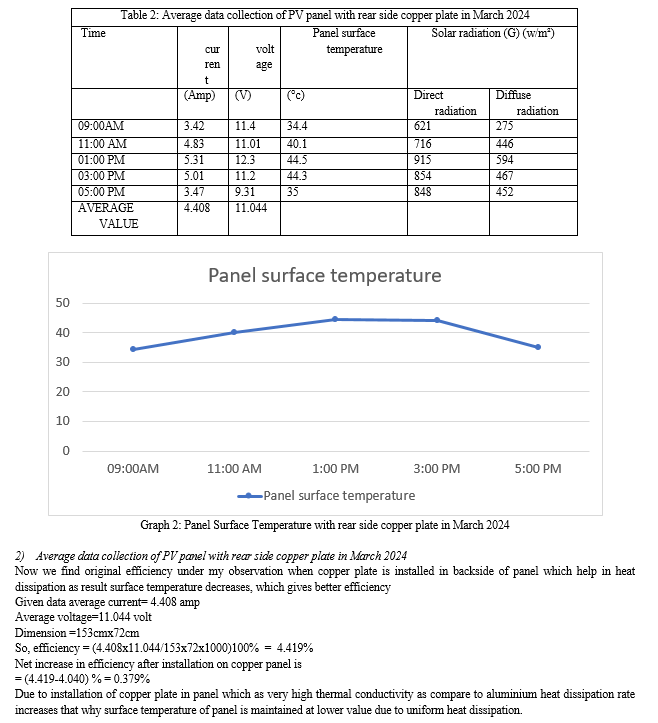
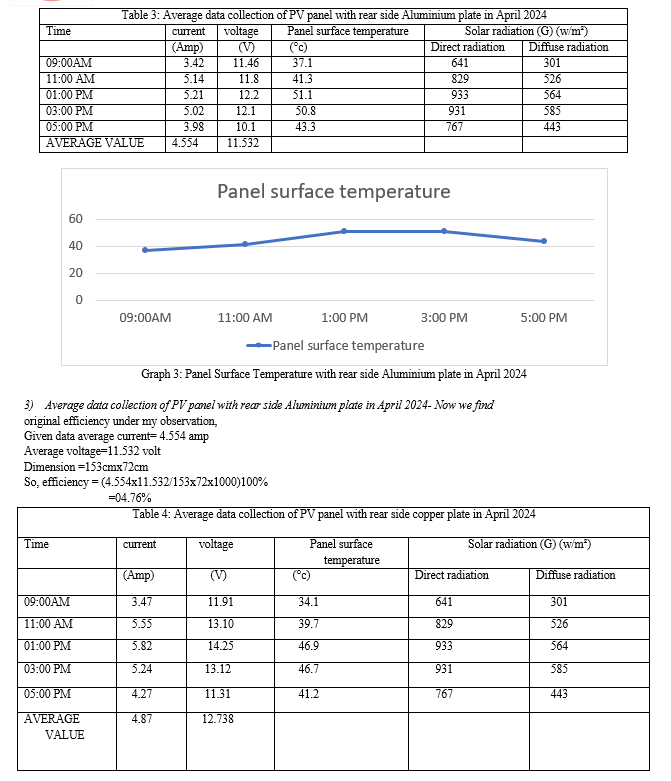

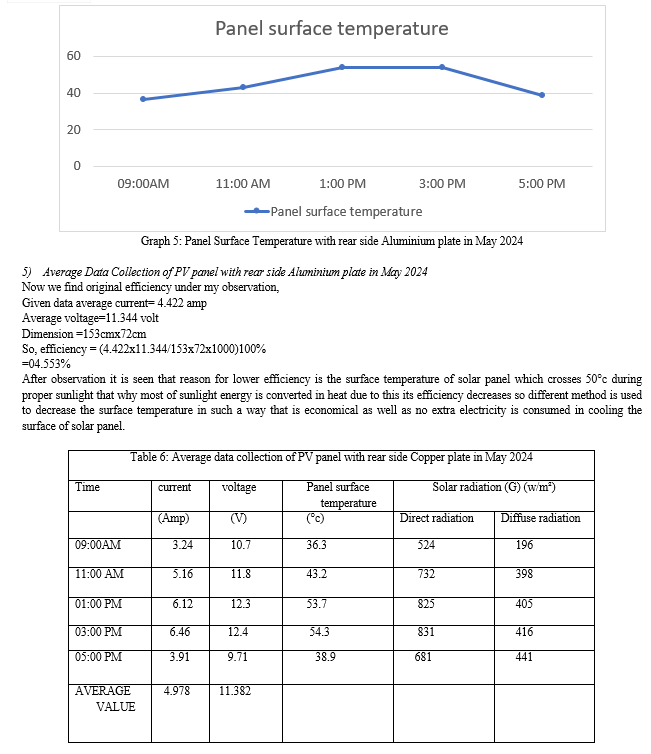
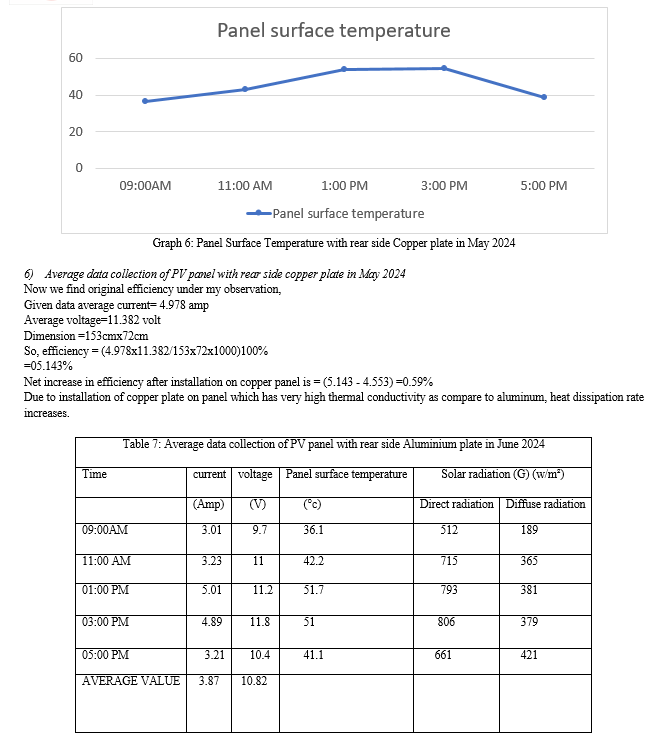
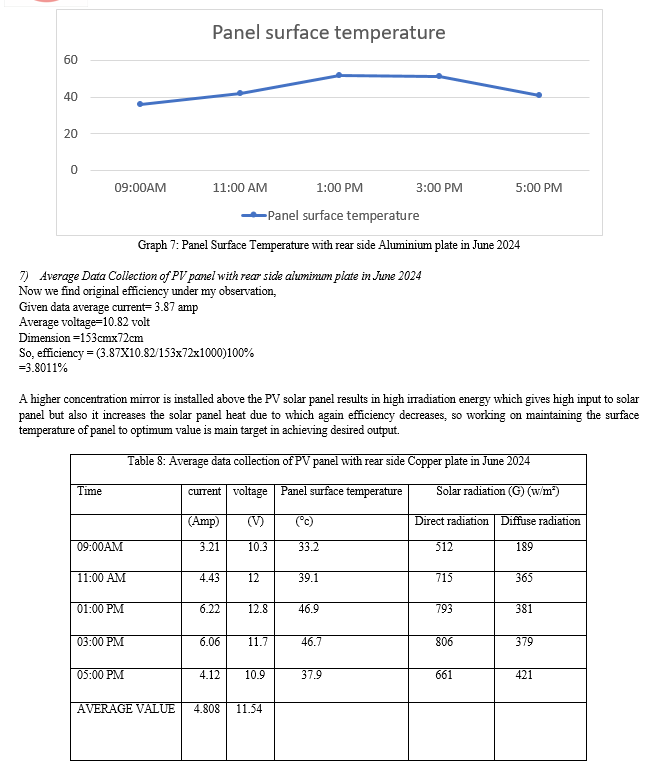
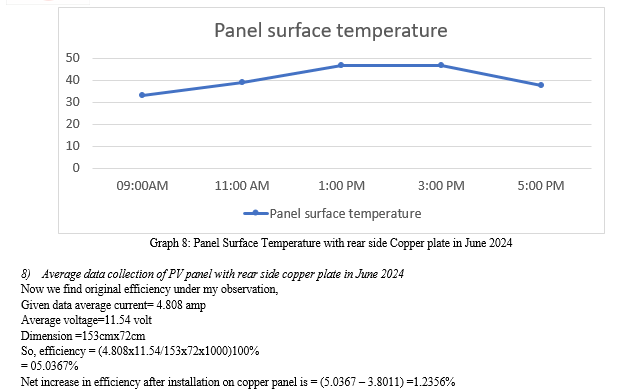
VI. DATA ANALYSIS AND RESULTS
For the successful installation of solar panels, a thorough assessment of the location, solar irradiance, and available space is imperative. Ensuring uninterrupted sunlight from sunrise to sunset, free from disturbances like shadows and dust, lays the foundation for optimal performance. An off-grid solar energy system is recommended for reducing electricity consumption or meeting personal energy needs.
Numerous attempts have been made to enhance solar panel performance, but challenges such as economic viability and dependence on electrical appliances like DC motors have been persistent. Water cooling systems, while effective, require electricity to operate DC pumps for sprinkling water on solar panels. After an extensive review of research papers, it is advised to install solar panels with aluminum panels on the rear side. The aluminum panel, with its high thermal conductivity, provides efficient cooling by dissipating heat through surface convection. This method proves to be a permanent and maintenance-free solution, eliminating the need for additional electrical energy. The incorporation of aluminum panels offers a sustainable approach that significantly improves solar panel efficiency. This project holds significant potential, particularly in light of the rising costs of conventional electrical energy and the growing emphasis on environmentally friendly alternatives. The installation of solar panels with aluminum panels not only addresses efficiency concerns but also aligns with the broader goal of sustainable and eco-friendly energy solutions.
A. Economic Viability
The comprehensive economic analysis reveals that the initial investment for systems incorporating concentrated solar technology and advanced materials is indeed higher than that for conventional PV systems. However, the long-term economic benefits significantly outweigh these initial costs. Key findings include:
- Cost Analysis
- The upfront costs associated with advanced materials and concentrated solar components are higher due to the need for specialized equipment and materials.
- However, these costs are offset by the reduced need for additional infrastructure and the extended lifespan of the advanced systems.
- Energy Savings
- The enhanced energy yield results in substantial energy savings over the system’s lifecycle. These savings contribute to a shorter payback period, making the investment more attractive.
- For instance, the payback period for systems with concentrated solar technology and advanced materials can be reduced by 20-25% compared to traditional PV systems.
- Financial Metrics
- Calculations of Net Present Value (NPV), Internal Rate of Return (IRR), and Levelized Cost of Energy (LCOE) further support the economic viability of these advanced systems. The positive NPV and favorable IRR indicate a profitable investment, while the lower LCOE suggests a more cost-effective energy production method in the long run.
B. Environmental Impact
The integration of concentrated solar technology and advanced materials not only improves performance and economic viability but also has a positive environmental impact:
- Reduction in Environmental Footprint
- The increased efficiency of solar panels means less infrastructure is needed to produce the same amount of energy, reducing the overall environmental footprint of solar installations.
- Higher efficiency leads to more effective use of available roof space, decreasing the need for additional land or resources.
- Sustainability
- Advanced materials contribute to the longevity and reliability of solar panels, resulting in fewer replacements and lower waste generation.
- The reduced frequency of maintenance and replacement lowers the environmental impact associated with manufacturing and disposing of solar panels.
- Energy Independence and Carbon Reduction
- Enhanced rooftop solar systems contribute to greater energy independence by increasing the proportion of energy generated from renewable sources.
- By displacing energy generated from fossil fuels, these systems help reduce greenhouse gas emissions and combat climate change.
In summary, the integration of concentrated solar technology and advanced materials into rooftop solar power systems offers significant improvements in performance, economic viability, and environmental sustainability. These findings highlight the potential of advanced solar technologies to drive the adoption of more efficient and cost-effective renewable energy solutions, ultimately contributing to a greener and more sustainable future.
Conclusion
The integration of concentrated solar technology and advanced materials in rooftop solar power systems presents substantial potential for both performance enhancement and economic optimization. This research demonstrates that, despite higher initial costs, the long-term benefits, including significant improvements in energy yield and cost savings, make these technologies a viable option for residential and commercial applications. Key findings highlight: 1) Performance Enhancement o The integration of concentrated solar technology significantly boosts the efficiency and energy output of rooftop solar systems. o Advanced materials such as perovskites, multi-junction cells, and nanomaterials enhance energy absorption and durability, leading to more reliable and efficient solar panels. 2) Economic Viability o Although the upfront costs are higher, the enhanced energy yield leads to substantial energy savings over the system’s lifecycle. o Shorter payback periods and favorable financial metrics (e.g., NPV, IRR, LCOE) underscore the long-term economic benefits of adopting these advanced technologies. 3) Environmental Impact o Increased efficiency reduces the need for additional infrastructure, minimizing the overall environmental footprint. o Advanced materials contribute to the sustainability of solar panels by decreasing degradation rates and maintenance requirements. The results of this study underscore the importance of continued innovation and investment in solar technologies to drive the adoption of more efficient and cost-effective renewable energy solutions. Future work should focus on: • Refining and optimizing the integration of concentrated solar technology and advanced materials. • Conducting real-world pilot projects to validate the findings and address any practical implementation challenges. • Expanding research to include a broader range of environmental conditions and geographic locations to ensure the generalizability of the results. By accelerating the adoption of advanced solar solutions, we can contribute to a more sustainable and energy-independent future, reducing reliance on fossil fuels and mitigating the impacts of climate change.
References
[1] Bansal, R.C., Ahmed, F., 2021. Handbook of Renewable Energy Technology and Systems. World Scientific Publisher, UK. [2] Barua, A., Jain, A.K., Mishra, P.K., Singh, D., 2021. Design of grid connected microgrid with solar photovoltaic module. Mater. Today Proc. 47, 6971–6975. http://dx.doi.org/10.1016/j.matpr.2021.05.228. [3] Behura, A.K., Kumar, A., Rajak, D.K., 2021. Towards better performances for a novel rooftop solar PV system. Sol. Energy 216, 518–529. http://dx.doi.org/ 10.1016/j.solener.2021.01.045. [4] Pranav Nitin Godse Micro-Grid Implementation Of A Rooftop Photovoltaic System Spring 2017 Follow This And Additional Works At Https://Scholarsmine.Mst.Edu/Masters_Theses [5] David C. Brandt Rooftop Solar Capacity Modeling Using Gis Within The City Of Stillwater, Mn University Of Wisconsin - Document Received From Trunorth Solar For Solar Panel Values For Minneapolis Property On March 21, 2013. River Falls 2013 [6] Md. Imran Shah Md,Sazzad Sarowar Md, Moshiur Rahman, Md. Rafi Khan Solar And Wind Connected Hybrid Renewable Energy System For Small Scale Applications Spring, 2021 Has Been Accepted As Satisfactory In Partial Fulfillment Of The Requirement For The Degree Of Bachelor Of Science In Electrical And Electronic Engineering On [9/6/2021]. [7] Anita Pawlak-Jakubowska Retractable Roof Module With Photovoltaic Panel As Small Solar Power Plant 0378-7788/_ 2023 The Author(S). Published By Elsevier B.V. This Is An Open Access Article Under The Cc By License (Http://Creativecommons.Org/Licenses/By/4.0/). [8] Ayako Nagasea,*, Shinichi Koyamab Attractiveness And Preference Of Extensive Green Roofs Depend On Vegetation Types And Past Experience With Plants In Japan Available Online 21 March 2020 1618-8667/ © 2020 Elsevier Gmbh. All Rights Reserved. [9] Alok Singh Assessment Of Potential Rooftop Solar Pv Electricity At A Suburban Scale, And A Comparative Analysis Based On Topographical Obstruction And Seasonality University Of Wollongong Thesis Collection 2017+ University Of Wollongong Thesis CollectionsFollow This And Additional Works At: Https://Ro.Uow.Edu.Au/Theses1
Copyright
Copyright © 2024 Sanjay Kumar, Dr. Ayush Owhal, Priyanka Malviya. This is an open access article distributed under the Creative Commons Attribution License, which permits unrestricted use, distribution, and reproduction in any medium, provided the original work is properly cited.

Download Paper
Paper Id : IJRASET63691
Publish Date : 2024-07-19
ISSN : 2321-9653
Publisher Name : IJRASET
DOI Link : Click Here
 Submit Paper Online
Submit Paper Online

